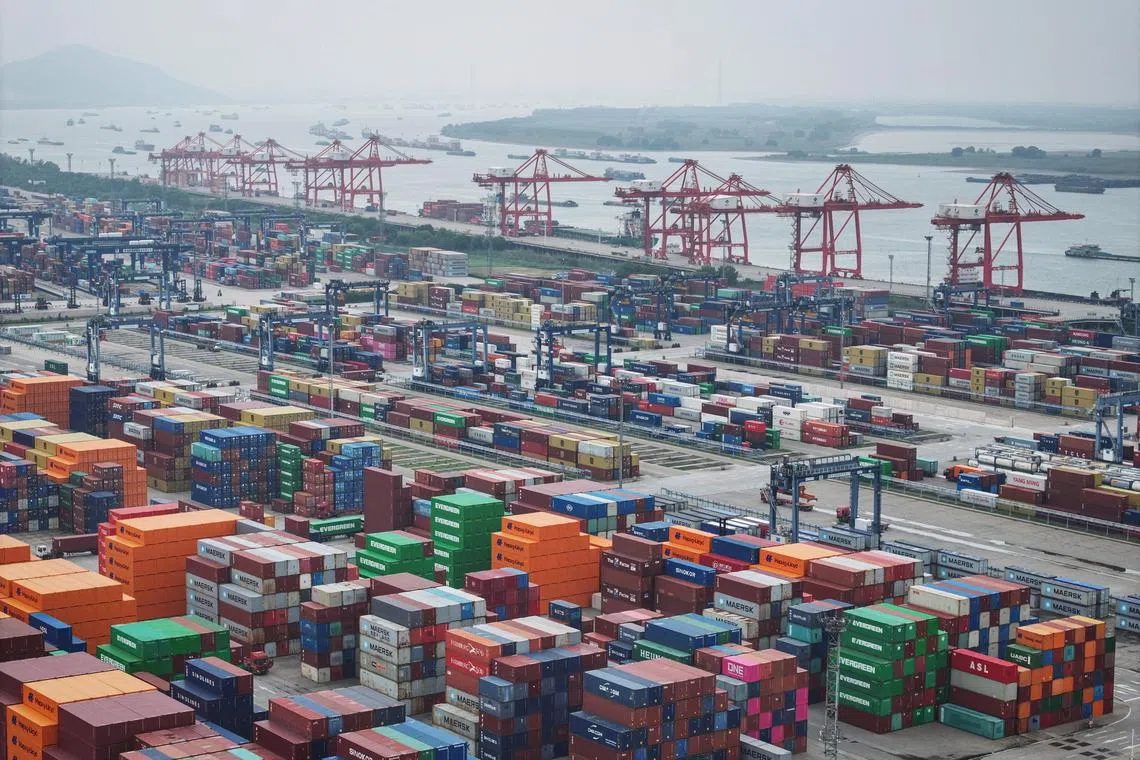China’s export growth slows sharply, imports shrink ahead of Trump tariffs
Sign up now: Get ST's newsletters delivered to your inbox

China’s outbound shipments grew just 6.7 per cent in November, Customs data showed on Dec 10, while imports shrank 3.9 per cent, their worst performance in nine months.
PHOTO: AFP
Follow topic:
BEIJING – China’s exports grew at a slower pace in November than the bumper month before, while imports unexpectedly shrank, in a worrying sign for the world’s No. 2 economy as President-elect Donald Trump’s imminent return to the White House brings fresh trade risks.
Trump has pledged to slap an additional 10 per cent tariff on Chinese goods
Outbound shipments grew just 6.7 per cent in November, Customs data showed on Dec 10, missing an 8.5 per cent forecast increase in a Reuters poll of economists and down from a 12.7 per cent rise in October.
More worryingly, imports shrank 3.9 per cent, their worst performance in nine months, dashing expectations of a 0.3 per cent increase and keeping alive calls for more policy support to prop up domestic demand.
Trump has previously said he will introduce tariffs in excess of 60 per cent on Chinese goods.
Meanwhile, unresolved tensions with the European Union over tariffs of up to 45.3 per cent on China-made electric vehicles threaten to open a second front in Beijing’s trade war with the West.
US tariff hikes pose a bigger threat to China this time round as its exports are one of its main growth drivers, with household and business confidence dented by a prolonged property crisis.
Government advisers are recommending that Beijing keep its growth target unchanged at around 5 per cent in 2025 and implement more forceful stimulus to mitigate the expected US tariffs by leaning on the country’s vast domestic consumer market.
“Global demand is not super strong. Data from other major exporters like South Korea and Vietnam points to different levels of slowdown too,” said Mr Xu Tianchen, senior economist at the Economist Intelligence Unit.
“Early signs of trade front-loading in anticipation of Trump’s tariffs next year have started to emerge, but the full impact will not be felt until the coming months, especially December and January,” he added.
China’s trade surplus grew to US$97.44 billion (S$130.5 billion) in November, up from US$95.72 billion in October.
ANZ senior China strategist Xing Zhaopeng attributed the poor import figure to falling commodity prices.
The world’s top crude buyer took in 48.52 million metric tonnes in November, up an annual 14.3 per cent, as lower prices of Middle East supplies and stockpiling demand boosted buying.
China’s coal imports rose 26 per cent year on year in November, a record high, as imported supply was cheaper than domestic coal.
Meanwhile, copper imports hit a one-year high, fuelled by shipments from Africa and purchases to restock domestic inventories of the key construction material, in an encouraging nod to an improving property sector.
The economy had recently seen some signs of stimulus trickling through, with manufacturers reporting the best business conditions in seven months in a November factory survey.
Firms said they were still receiving fewer export orders, however, suggesting that buyers remain hard to come by in a slowing global economy and exporters are moving stocks to warehouses abroad in anticipation of demand picking up again.
South Korea’s exports, a leading indicator of China’s imports, slowed to the weakest level in 14 months in November.
Outbound South Korean shipments to China fell for the first time in eight months, pointing to Chinese manufacturers buying fewer Korean components for re-export in finished electronics goods.
Top policymakers are expected to meet this week to set out their priorities for 2025. Investors will be looking for fresh policy support for local governments and the property sector from the Politburo.
REUTERS

